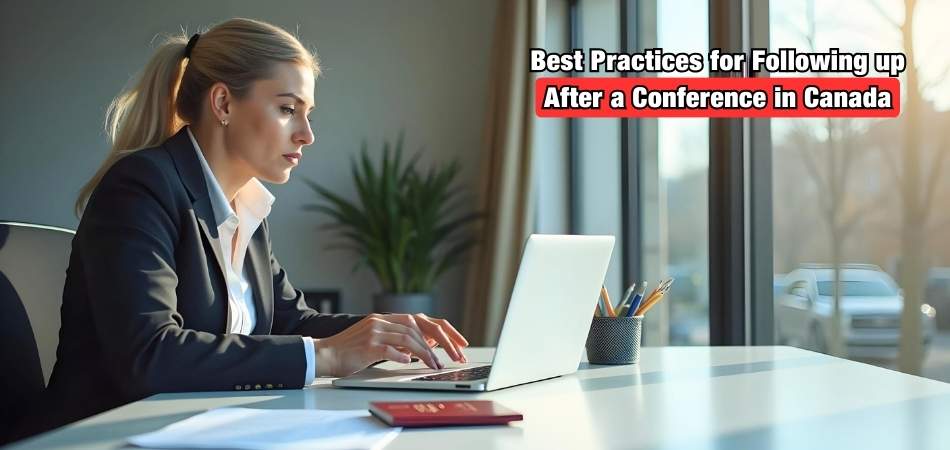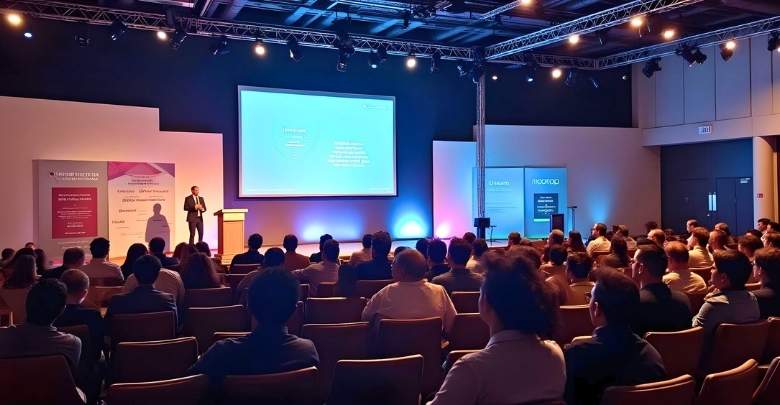Following up after attending a conference is a crucial step in maintaining professional relationships. While the event provides the platform to network and learn, what you do afterward determines the long-term impact. Many professionals question, What are the best practices for following up after a conference in Canada?
Following up effectively involves personalized communication, timely outreach, and strategic planning. Sending customized emails, connecting on professional platforms, and organizing your contacts are all essential. Additionally, sharing key takeaways and planning for future interactions ensures your efforts translate into meaningful opportunities. These steps help maximize the value of your conference experience.
Are you curious about how to make the most of post-conference follow-ups? This article covers everything you need to know about best practices, ensuring you maintain connections and create lasting professional relationships. Read on to discover actionable insights!
Why Is Following Up After a Conference Essential in Canada?
Attending a conference is only the first step in maximizing its benefits. Following up afterward solidifies the connections you’ve made, helping to transform initial introductions into meaningful relationships. It’s an opportunity to maintain the momentum created during the event.
Engaging with contacts after the conference reinforces your professional presence. A well-timed follow-up shows initiative and interest, leaving a lasting impression on peers and industry leaders. It also opens doors for collaborations, mentorship, or partnerships that can advance your career goals.
Canadian conferences are known for promoting innovation and creating opportunities to connect with diverse professionals. Following up after a conference in Canada is especially crucial as it helps you build relationships in a dynamic, globally recognized professional environment. This ensures you don’t miss out on the long-term benefits of these connections.
What Are the Best Practices for Following up After a Conference in Canada?
Following up after a conference is an essential part of maximizing its value. It solidifies connections, supports professional growth, and opens avenues for collaboration. Here are the best practices to follow:
Send Personalized Follow-Up Emails
A personalized email is one of the most effective ways to reconnect with people you met during the conference. Address your contacts by name and reference specific points from your conversation to make the email more meaningful. Clearly state your purpose, whether it’s to express gratitude, propose collaboration, or simply maintain the connection. Ensure your tone is professional yet approachable to leave a lasting impression.
Connect on Professional Platforms
Professional networks like LinkedIn provide an excellent platform to continue the dialogue. Send a personalized connection request, mentioning where and how you met during the conference. Once connected, engage with their content or share relevant articles to stay visible. This approach maintains a professional presence and keeps you connected with industry peers over the long term.
Organize Your Notes and Contacts
Immediately after the conference, review your notes and organize the contacts you gathered. Categorize them by relevance to your career goals, such as potential collaborators, mentors, or industry leaders. This structured approach helps prioritize follow-ups and ensures that no important connections are overlooked. Maintaining an organized database of contacts is a valuable resource for future interactions.
Share Key Takeaways with Your Network
Sharing insights or key takeaways from the conference demonstrates your engagement and positions you as a thought leader. Create a summary of what you learned and post it on platforms like LinkedIn or your organization’s blog. Tag or mention individuals from the conference who contributed to your experience. This not only showcases your learning but also reinforces connections made during the event.
Plan for Future Interactions
Following up should not be a one-time effort; aims to build long-term relationships. Schedule periodic check-ins or invite contacts to relevant industry events. For those who showed mutual interest, propose specific collaboration opportunities. A proactive approach to maintaining relationships ensures that the connections made at the conference turn into meaningful professional networks.
Avoid Overwhelming Your Contacts
While it’s essential to follow up, it’s equally important to respect the other person’s time. Avoid sending lengthy emails or overly frequent messages that may come across as intrusive. Focus on quality rather than quantity in your communications. Being considerate strengthens the connection and ensures mutual respect.
Express Gratitude and Offer Value
Take the time to thank individuals you met for their insights, time, or assistance during the conference. Expressing gratitude leaves a positive impression and reinforces the connection. Beyond gratitude, look for opportunities to offer value, such as sharing a resource, article, or industry insight relevant to their interests.
By implementing these best practices, you can effectively capitalize on the connections and insights gained during a Canadian conference. Thoughtful follow-ups ensure that the professional relationships you establish continue to grow and contribute to your career development.
How to Turn Conference Contacts into Long-term Collaborations?
Conferences provide excellent opportunities to meet like-minded professionals and industry leaders. Turning these initial contacts into long-term collaborations requires strategic effort and consistent communication. Here’s how to develop meaningful partnerships.
Follow Up Promptly and Personally
Reach out to your conference contacts within a few days to maintain the connection while the interaction is still fresh. Personalize your follow-up message by referencing the specific conversation or topic you discussed. This approach demonstrates genuine interest and reinforces the connection. Being prompt also sets the tone for a collaborative and professional relationship.
Share Mutual Value
Offer value in your interactions by sharing resources, insights, or opportunities that align with your contact’s interests or expertise. This could include sending a relevant article, introducing them to someone in your network, or inviting them to an upcoming event. For those looking to network effectively at a Canadian industry conference, sharing recommendations or event insights can strengthen your bond. Mutual value exchange builds trust and encourages collaboration.
Schedule Follow-Up Meetings
Initiate a follow-up meeting, either virtually or in person, to deepen your connection. Use this opportunity to explore common goals, challenges, or potential areas for collaboration. A structured discussion helps both parties identify ways to work together effectively. Regular meetings keep the relationship active and focused on creating value for both sides.
Use Social Media and Digital Platforms
Stay engaged with your contacts through professional platforms like LinkedIn by commenting on their posts, sharing their achievements, or tagging them in relevant discussions. This digital engagement keeps you visible in their professional sphere without being intrusive. Consistent interaction builds familiarity and keeps the collaboration potential alive.
Propose Collaborative Projects
When the relationship is well-established, propose specific projects or initiatives that align with both parties’ goals. Be clear about the objectives, roles, and benefits of the collaboration to create a shared vision. A well-thought-out proposal demonstrates your commitment to building a productive partnership and helps turn ideas into actionable plans.
Key Benefits of Attending and Following Up After a Conference in Canada
Attending a conference in Canada is a valuable experience for professionals seeking to expand their knowledge and network. Following up after the event amplifies these benefits, turning initial interactions into meaningful opportunities. Here are the key advantages.
Expanding Your Professional Network
Conferences are prime environments for meeting industry leaders, peers, and potential collaborators. Engaging with diverse attendees allows you to build a network that supports professional growth. Following up after the conference helps solidify these connections, creating opportunities for partnerships, mentorship, or career advancements.
Gaining Actionable Insights and Knowledge
The sessions, workshops, and keynote speeches at conferences provide valuable insights into industry trends and challenges. Following up allows you to continue the conversation, gaining deeper perspectives on the knowledge shared during the event. Reviewing session materials and connecting with speakers enriches your learning.
Earning Professional Development Credits
Many conferences offer opportunities to earn credits that contribute to your career progression. For instance, you can gain professional development credits at conferences in Canada by attending accredited workshops or sessions. These credits validate your commitment to learning and help meet industry-specific requirements.
Enhancing Your Visibility and Personal Brand
Attending and actively participating in conferences positions you as an engaged professional within your field. Following up with attendees, speakers, and organizers reinforces your visibility and strengthens your reputation. Sharing your conference takeaways on platforms like LinkedIn highlights your expertise and commitment to growth.
Strengthening Collaborative Opportunities
Following up after a conference enables you to explore collaborations discussed during the event. Reaching out to new contacts with customized proposals or shared goals can lead to meaningful partnerships. Whether it’s co-authoring research, launching a project, or joining a panel discussion, these collaborations can significantly improve your career.
Tips for Personalizing Your Follow-Up Communication
Personalized follow-up communication leaves a lasting impression and builds stronger professional relationships. Personalizing your message shows genuine interest and ensures your outreach stands out. Here are key tips for creating meaningful and personalized follow-up communication.
- Reference Your Initial Interaction: Mention where and how you met to remind your contact of your initial conversation. This adds context to your message and demonstrates attentiveness.
- Address Them by Name: Using your contact’s name in the message shows respect and attention to detail. It makes your communication feel more direct and personal.
- Highlight Shared Interests or Goals: Bring up topics you discussed during your meeting, such as shared industry challenges or goals. This reinforces the connection and adds relevance to your follow-up.
- Express Gratitude: Thank them for their time or insights shared during the conference. Gratitude makes your message warm and strengthens the tone of your professional outreach.
- Offer Value: Include a helpful resource, article, or follow-up on something they mentioned during your conversation. Providing value demonstrates your commitment to developing a meaningful relationship.
- Be Clear About Your Intentions: Clearly state why you’re following up, whether it’s to continue a discussion, propose a collaboration, or simply maintain the connection. This eliminates ambiguity and makes your message more effective.
- Use the Right Communication Medium: Choose a platform they’re most comfortable with, such as email, LinkedIn, or even a phone call if appropriate. This consideration adds a layer of thoughtfulness to your outreach.
- Proofread and Keep It Professional: Ensure your message is free of errors and maintains a professional tone. Attention to detail shows respect and professionalism, leaving a positive impression.
FAQs
Many professionals often wonder about the best strategies to maintain and grow these connections post-conference. Below are common questions with actionable insights to help you complete this process effectively.
How Can I Effectively Prioritize My Follow-Ups After a Conference?
Prioritize your follow-ups by organizing contacts based on relevance to your career or goals. Categorize them into potential collaborators, mentors, or industry peers. This structured approach ensures that you engage with the most impactful connections first without overlooking anyone important.
What Should I Include in a Follow-Up Email After a Conference?
A follow-up email should be personalized and reference your initial conversation at the conference. Start with a warm greeting, express gratitude for their time, and include specific topics you discussed. End the email by proposing the next steps, such as scheduling a meeting or staying connected.
How Can I Build Long-Term Relationships With Conference Contacts?
Long-term relationships require consistent effort and value exchange. Stay connected through LinkedIn by engaging with their posts or sharing relevant articles. Propose follow-up meetings or collaborative projects that align with mutual interests to deepen the professional bond over time.
Is It Necessary to Follow Up Even If There’s No Immediate Opportunity?
Yes, following up shows initiative and maintains the connection for future opportunities. Even if no immediate collaboration is possible, staying in touch keeps you on their radar. Regular engagement can eventually lead to fruitful partnerships or knowledge-sharing.
What Tools Can I Use to Stay Organized During the Follow-Up Process?
Tools like CRM software, Excel spreadsheets, or apps like Evernote help you track your follow-ups efficiently. These tools allow you to log contact details, conversation summaries, and reminders for future interactions, ensuring you don’t miss critical connections.
Final Thought
Following up after a conference is a vital step to maintaining the connections you’ve worked hard to establish. By personalizing your communication, organizing your contacts, and engaging through professional platforms, you can create meaningful and lasting relationships. These strategies ensure your efforts are effective and impactful, answering the question, What are the best practices for following up after a conference in Canada?
To maximize your follow-up, stay consistent, add value to your interactions, and respect your contacts’ time. These thoughtful gestures not only strengthen your network but also open doors to future collaborations and growth. Best wishes on turning your conference experience into a long-term success!








